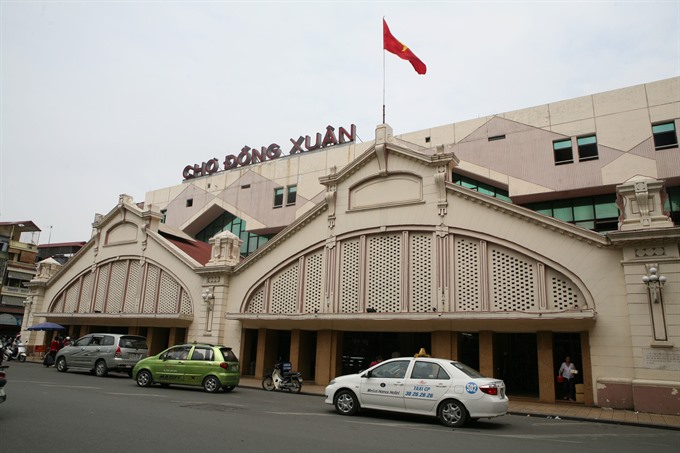 |
| Trading hub: The architecture of Dong Xuan market in the heart of Ha Noi is known for its tropical features, though it was designed and constructed by the French in 1889 when they embarked on exploiting Indochina colonies. VNS photo Truong Vi |
Viet Nam News
by Luong Huong & Hong Van
Located in the centre of Hà Nọi, Dòng Xuan Market has become an iconic landmark that has witnessed many ups and downs of the 1,000-year-old capital.
The architecture of the market is known for its tropical features, though it was designed and constructed by the French in 1889 when they embarked on exploiting Indochina colonies.
Specifically, the two-layer corrugated iron roof of the building aims to aid ventilation and release heat. Initially, the market had a total area of about 6,500m2 including a complex of five adjacent houses. The façade of the market consists of five big entrances featuring French-style doors, and the whole building is sheltered by air-gap walls that maximise ventilation and absorb natural light.
Additionally, according to architect Dào Ngọc Nghiem, vice chairman of the Ha Noi Association for Urban Planning and Development, the French skillfully designed the dome of the market similar to the entrance of the Imperial Citadel of Thang Long, which combined with French-style architecture to create a special building.
The architecture of the market reveals that its designer aimed to create a typical market for a tropical area, seeking harmony between French and indigenous culture in the late 19th and early 20th centuries.
It was also one of the first examples of how Vietnamese architectural elements were integrated into French-style buildings in the city.
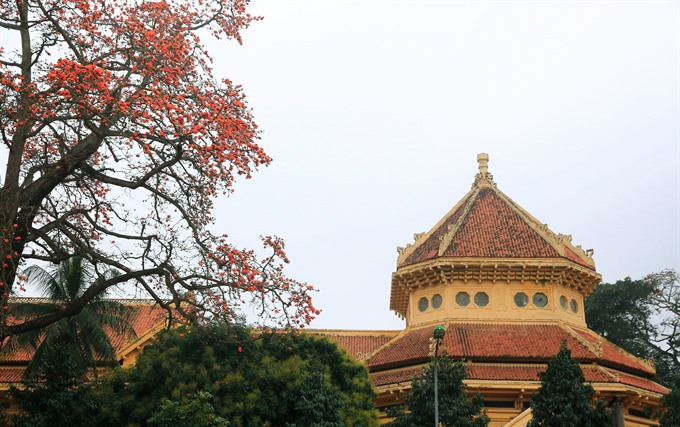 |
| Mix of styles: Louis Finot Museum, presently known as the National Museum of Vietnamese History, features many examples of Vietnamese architecture, particularly in its roof system. VNS photo Truong Vi |
East meets West
The French colonists first came to Viet Nam in the late 19th century. In 1886, the French in Ha Noi established the municipal council with the aim of "turning Ha Noi into a European city".
Over a history of more than 100 years in Viet Nam, and Ha Noi in particular, the French left a valuable, unique and advanced heritage of their architecture and structures in Ha Noi.
Before French colonialism, Ha Noi had three major components: the imperial citadel, commercial zone (the Old Quarter which featured streets on which a number of crafts and merchandise were sold) and the surrounding rural area.
Ha Noi at that time was considered the administrative centre of the whole Indochina. The city planning that French architects brought to Ha Noi gave it a new face.
Ha Noi, with mud-walled cottages, was transformed into a more organised, orderly city which featured both traditional tube houses in the Old Quarter, elegant houses and villas for the French living in Ha Noi and well off native merchants, the chessboard streets, tree-lined boulevards, entertainment structures imported from France as well as the advanced system of drainage, planned grid network of streets and parks, and public spaces for the community.
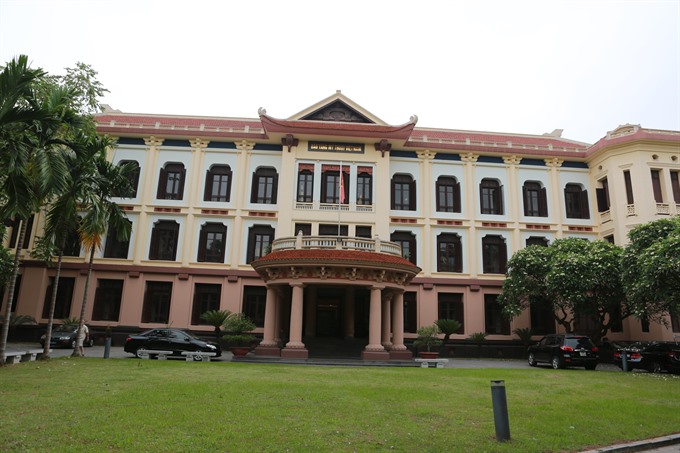 |
| Home of art: The curved corners of the roofs, a typical Vietnamese design, can be seen at the Vietnam National Museum of Fine Arts, a construction by the French in the 1930s. VNS photo Truong Vi |
The French buildings and structures in Ha Noi belong to various styles – neo-classical, Indochina style, art deco – yet the finest and most important would be Indochina style. It is a fusion of modern and traditional architectural elements, of French and Vietnamese style that brought structures into harmony with the townscape as well as the tropical climate of Ha Noi.
“When the French arrived in Viẹt Nam, they were impressed with the local architecture that was both beautiful and suitable to local culture, climate and scenery. In the second phase, after the First World War, more Vietnamese or Oriental elements were integrated into the structures to create a new architectural style, or Indochina style,” says architect Tran Quoc Bao, a lecturer at the National University of Civil Engineering and also a member of the Group of Researchers on Architecture of Ha Noi.
In the mid-1920s, a series of buildings were constructed in the Indochina style. The leading architect of this style, later on known as Indochina-style architecture, was E. Hébrard from France. After years of working in Indochina, he held a special interest in the indigenous culture and created many building projects in both Hà Nọi and Dà Lạt in the Central Highlands province of Lam Dòng.
The representative buildings for this architectural style in Hà Nọi include the l’Universite d’Indochine, Louis Finot Museum, Direction des Finances, Church of Martyrs and Institut Pasteur.
What is interesting about such buildings is that their interiors are totally in the French style and operate like any French buildings, but they are sheltered by Vietnamese-style structures.
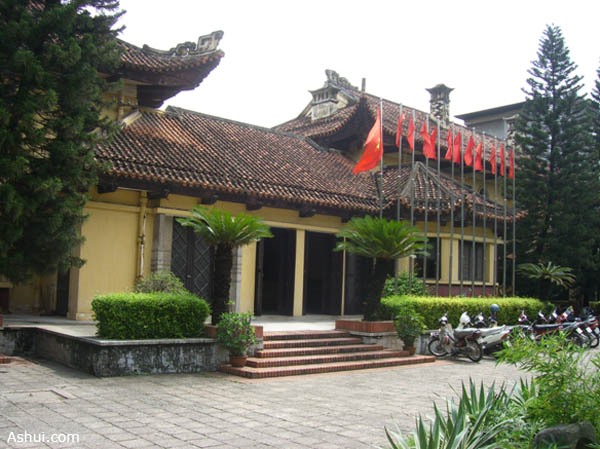 |
| Complementing nature: The most popular Vietnamese features that could be found in Indochina-style buildings include the heat-proof roof, the system of light and ventilation, in addition to the maximum use of trees. Photo ashui.com |
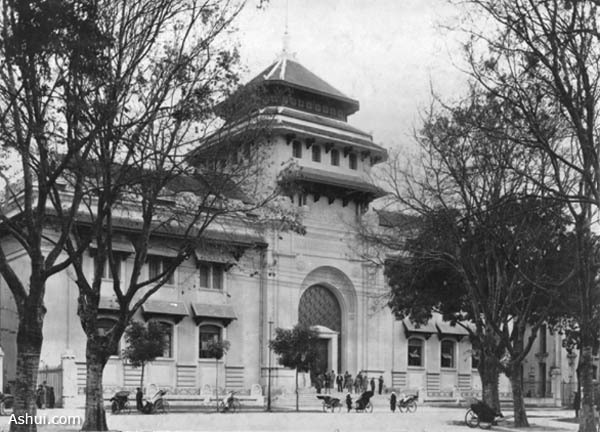 |
| Classic design: The l’Universite d’Indochine (University of Indochina) is a charateristic building of Indochina architectural style. Over a history of more than 100 years in Ha Noi, the French left a valuable, unique and advanced heritage of their architecture and structures in Ha Noi. Photo ashui.com |
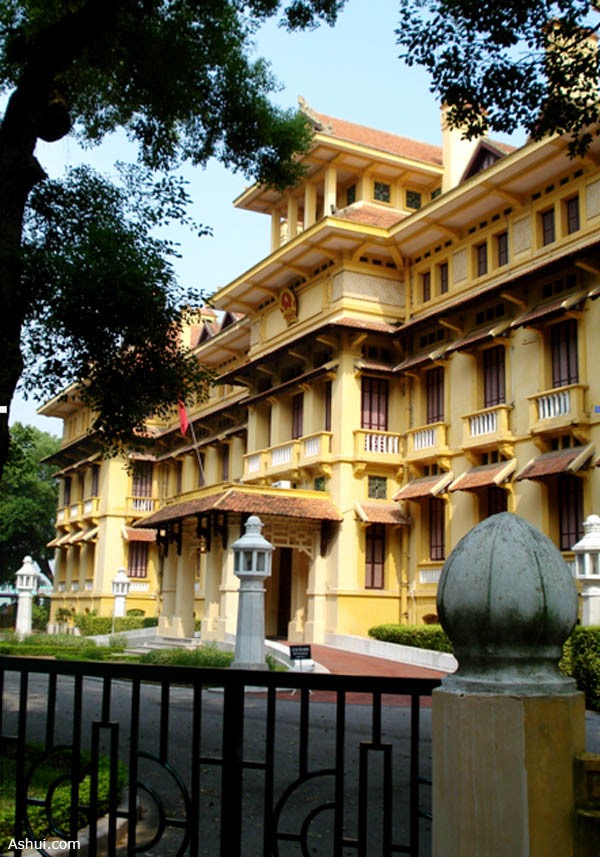 |
| Still in use: Direction des Finances, designed by French architect E. Hébrard in 1924, has become the head office of the Ministry of Foreign Affairs. Photo ashui.com |
The most popular Vietnamese features that could be found in Indochina-style buildings include the heat-proof roof, steep porch sheltering the buildings from rain and sun, the system of light and ventilation, in additional to the maximum use of shady trees.
“Architecturally speaking, Vietnamese patterns used in French buildings were utilised particularly in the villas and condos, designed by a renowned French architecture and located on Tràn Phú and Lý Nam Dé Streets,” Bao says.
In many Indochina-style villas, the tiled roofs contain many layers. The corners of the roofs are curved up and decorated with typical Vietnamese patterns like dragons, while the houses might be decorated with relief figures inspired by Oriental art.
According to architect Nghiem, the Indochina-style buildings and structures in Ha Noi are an important heritage, reflecting the creative application of French architectural solutions in Viet Nam’s natural and cultural conditions.
Additionally, the bamboo or cloth curtain used in Vietnamese houses at the time was replaced by glass windows though which sunlight could still be absorbed to avoid the heat of Ha Noi.
“The Indochina-style structure is an important symbol of integration, yet not losing the identity of Viet Nam,” says Nghiem.
Current state
According to architect Bảo, there are nine public Indochina-style mansions and condos, which also now serve as public buildings, in good condition in the capital.
“Most of the public buildings are used similarly to their original functions. For example, the l’Universite d’Indochine is now the location of Viẹt Nam National University, Louis Finot Museum has been used as the National Museum of Vietnamese History, and the Direction des Finances has become the head office of the Ministry of Foreign Affairs.
Two major villas, on 36 Tràn Phú Street and 4 Lý Nam Dé, have been transformed into public buildings, but their space is still well preserved,” he says.
According to a recent survey, there are around 1,600 French-style villas in the capital, among which over 500 villas are privately-owned and over 1,000 others are state-owned.
“The restoration and renewal of the French-style public buildings has been conducted methodologically, leaving barely any changes to their original states. Some privately-owned villas and condos; on the other hands, are suffering from severe deterioration,” he says.
Conservation
Ha Noi Department of Planning and Architecture has cooperated with the Urban and Architecture Institute to carry out the project "Preservation of French Architecture Legacy" in Ha Noi.
The project developed a list of criteria to evaluate the value of French houses in Ha Noi.
Factors taken into account include: architectural value (40 points), authenticity (20 points), historical and cultural value (15 points), planning and landscape value (15 points), functions and ownership (10 points). Those awarded more than 75 points will be listed as ‘especially valuable’, those with 60 to 74 points listed as ‘highly valuable’ and the rest listed as having ‘average value’.
“It is important that experts carefully evaluate the current state as well as cultural, historical and architectural value of the structures and classify them to put them in the order of preservation priority,” says Nghiem.
“We do not have sufficient budget for the preservation of all structures. We need to conduct surveys to find the current state of these structures, carefully evaluate them and include the most valuable and characteristic in the list of strict conservation. The authorities should work out a detailed policy and instructions for this and listing must be based on very careful surveys and research.
“What is more important is that the structures shouldn’t be treated as a relic but a ‘living’ structure with functions and values still maintained and continued today,” says Nghiem.
"We can learn from the conservation experience of other countries, for example Italy, Singapore or Thailand. There may be hundreds of ancient valuable houses but only a few are listed among the structures put under strict conservation schemes."
Rapid urban development poses some challenges in conserving the city’s heritage. Ha Noi has yet to develop a plan and specific solutions for such conservation. We should also tap the role of the community in conservation. There must be an agreement between experts and the community.
“We need to call for sponsors as well as owners to join in conservation work. The proceeds from tourism activities will be shared with owners and sponsors. Privatisation is a practical solution as we can hardly rely on the state budget for conservation work,” Nghiem adds.
Besides the preservation efforts of high-value French-style buildings in the capital, the architectural experts have also raised concerns about the mass construction of new buildings with French inspiration, which however, due to improper study of design, lack architectural authenticity.
“The French-style buildings are valuable property of the city only when they are built in the proper period of time. It is already the 21st century, so there should no more new constructions of Indochina-style buildings in particular and French-style buildings in general in the city,” architecture lecturer Bao says. VNS
OVietnam